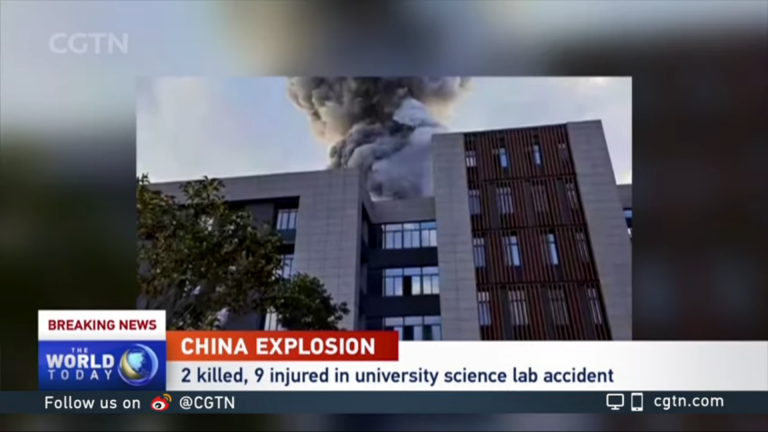A fatal explosion in a lab at Nanjing University in China that killed two and injured nine others has been the latest in a long series of incidents sparking safety concerns.
The incident occurred at the Nanjing University of Aeronautics and Astronautics (NUAA), in Jiangsu province, on Oct. 24. An investigation into the circumstances that led up to the incident is ongoing, said a post by the university to the Chinese social media Weibo.
“At 15:52 on October 24, 2021, the materials laboratory of the College of Materials Science and Technology of the general road campus of our university exploded, causing a fire. The local fire rescue station arrived at the scene for disposal first and extinguished the open flame in time. The school immediately sent 11 injured people to the hospital for treatment, and 2 of them died after ineffective rescue. the specific reason is under investigation,” the post read.
The Chinese state media outlet Global Times noted the accident had sparked “renewed safety concerns,” saying that “Chinese chemists have been calling for improvements to lab safety at research institutions following previous incidents, which reflect systematic negligence of safety.”
Earlier explosions
On March 31, a blast at the Institute of Chemistry of the Chinese Academy of Sciences killed a graduate student in Beijing.
Success
You are now signed up for our newsletter
Success
Check your email to complete sign up
On December 26, 2018, three students conducting a sewage-treatment experiment at the environmental engineering laboratory at Beijing Jiaotong University were killed.
On Sept. 29, the intermediate people’s court in Shanghai sentenced Donghua University in Shanghai to pay 1.62 million Yuan (US$250,000) to a scholar wounded in an explosion at a laboratory of the Academy of Chemistry, Chemical engineering, and Bioengineering in Sept. 2016.
One casualty occurred in December 2015 at the chemistry department of the Tsinghua University in Beijing and another one in April 2015 at the China University of Mining and Technology in Xuzhou.
The list is far from complete.
Scientific study
A study by researchers at the China University of Petroleum in Qingdao on safety issues at university labs throughout the country, which was published in November, showed that accidents in labs seem to have been on the rise over the past two decades, Nature reported.
Researchers tallied 102 injuries and ten fatalities during 110 publicly documented lab mishaps in China between 2000 and 2018. They fear that the actual number of accidents might be significantly higher as some incidents could have gone unreported.
According to the study, the 2018 Jiaotong University blast — which caused three deaths and ruined the whole laboratory — was generated by the ignition of 66 kilograms (145.5 pounds) of unduly stowed magnesium powder.
According to the scientists, this was the first university lab accident for which an extensive investigation was put up, which was published online on a governmental website.
Stiffer regulations
According to Global Times, Chinese national authorities also ramped up their safety protocols concerning production, sale, transportation, and storage of dangerous substances after the Jiaotong incident. Also, reportedly, twelve university officials were disciplined.
The researchers also noted that the number of graduate students in subjects involving lab practices had dramatically increased from 90,000 in 2000 to about 5.3 million in 2019, which may have accounted for the increase in casualties.
READ MORE: Pair of Natural Gas Explosions Rock Northeast China, Destroying Buildings, Roads
According to Samuel Yu, director of the Health, Safety and Environment Office at the Hong Kong University of Science and Technology, significant improvements have been made, including safety features such as fume cupboards and emergency showers. “Compared with 20 years ago, lab safety in China has definitely made significant progress,” Yu says, adding that this “is most obvious in the leading universities.”
However, Yu questions whether there’s a one-size-fits-all solution to the problem. “The fatal lab accidents that we are aware of usually have multiple faults adding up to the tragic outcome, so I don’t think there is a single magic bullet,” he says.














